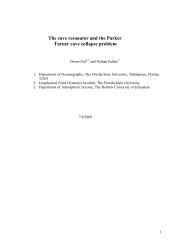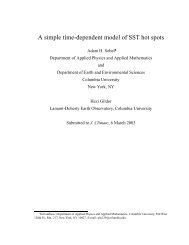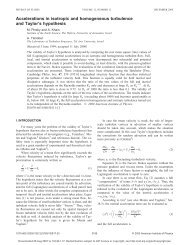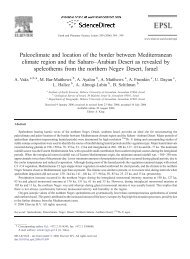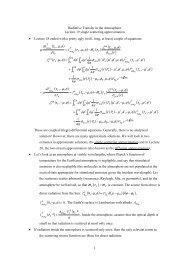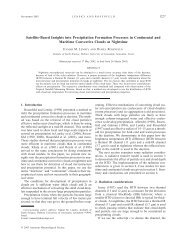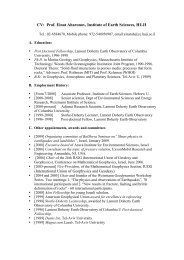Copper isotope fractionation in sedimentary copper mineralization ...
Copper isotope fractionation in sedimentary copper mineralization ...
Copper isotope fractionation in sedimentary copper mineralization ...
Create successful ePaper yourself
Turn your PDF publications into a flip-book with our unique Google optimized e-Paper software.
242 D. Asael et al. / Chemical Geology 243 (2007) 238–254<br />
Cambrian Timna bas<strong>in</strong>. The TIC is unconformably overla<strong>in</strong><br />
and onlapped by a sequence of <strong>sedimentary</strong> Cambrian<br />
rocks consist<strong>in</strong>g of the fluvial sandstones [Amudei<br />
Shelomo (Solomon's Pillars) Formation], the Lower<br />
Cambrian Timna Formation, and Middle Cambrian<br />
cont<strong>in</strong>ental sandstones of the Shehoret Formation.<br />
The Timna Formation consists of the lower Member<br />
(Hakhlil) overla<strong>in</strong> by the upper Member (Sasgon), which<br />
formed <strong>in</strong> a mar<strong>in</strong>e lagoonal–sabkha environment<br />
dur<strong>in</strong>g a mar<strong>in</strong>e transgression. <strong>Copper</strong> m<strong>in</strong>eralization<br />
predom<strong>in</strong>antly occurs <strong>in</strong> the sandstones, dolomites and<br />
shales of the Sasgon Member (Fig. 2b), as well as <strong>in</strong> the<br />
Shehoret Formation sandstones (Bentor, 1956; Wurzburger,<br />
1967; Garfunkel, 1970; Bartura and Wurzburger,<br />
1974; Segev, 1986; Shlomovitch et al., 1999). Lower<br />
Cretaceous Formations, which unconformably overlie<br />
the Cambrian sediments, also feature m<strong>in</strong>or <strong>copper</strong><br />
m<strong>in</strong>eralization, most probably derived by rework<strong>in</strong>g of<br />
the Cambrian deposits (Kedar, 1984). These Lower<br />
Cretaceous cupriferous sandstones are not studied <strong>in</strong> this<br />
work, which is restricted to the Cambrian and Precambrian<br />
rocks.<br />
Intense erosion and penepla<strong>in</strong>ization of the Timna<br />
igneous rocks has left few exposures of the <strong>copper</strong><br />
porphyry rocks. Primary igneous <strong>copper</strong> m<strong>in</strong>erals <strong>in</strong> the<br />
exposed rocks have undergone secondary temperature<br />
alteration (most probably supergene), and only m<strong>in</strong>ute<br />
relics of igneous chalcopyrite are found (Wurzburger,<br />
1967).<br />
Sedimentary Cu-sulphides occur <strong>in</strong> dolomite rocks of<br />
the Timna Formation as dispersed mm to cm sized<br />
spherules (Fig. 3a and b). The dolomites are strictly<br />
mangano-dolomites with up to 2.8 wt.% manganese as<br />
Mn 2+ <strong>in</strong> the dolomite lattice (Bar-Matthews, 1987;<br />
Segev and Sass, 1989). The Cu-sulphides are <strong>in</strong>terpreted<br />
to have formed <strong>in</strong> reduc<strong>in</strong>g conditions dur<strong>in</strong>g early<br />
diagenesis (Shlomovitch et al., 1999). These Cusulphides<br />
were then replaced by Cu(II) m<strong>in</strong>erals <strong>in</strong><br />
two stages: 1) alteration to malachite (Cu 2 (OH) 2 CO 3 ),<br />
which armours and sometimes completely replaces the<br />
sulphide m<strong>in</strong>erals and is the only time that this m<strong>in</strong>eral<br />
formed <strong>in</strong> the Cambrian <strong>sedimentary</strong> sequence; 2) development<br />
of paratacamite (Cu 2 (OH) 3 Cl) as ve<strong>in</strong>s<br />
emanat<strong>in</strong>g from the sulphides and cross-cutt<strong>in</strong>g the<br />
dolomitic rocks. <strong>Copper</strong> silicates are pr<strong>in</strong>cipal m<strong>in</strong>erals<br />
of the sandstones and shales of the Timna and Shehoret<br />
Formations. Optical microscope and scann<strong>in</strong>g electron<br />
microscope (SEM) studies show that these m<strong>in</strong>erals<br />
formed by the reaction of quartzo-feldpathic m<strong>in</strong>erals<br />
with Cu(II) solutions (Charach et al., 1976; Shlomovitch<br />
et al., 1999; Fig. 3d). The high abundance of <strong>copper</strong> <strong>in</strong><br />
sandy lithofacies of the Timna Formation has also been<br />
attributed to <strong>in</strong>-situ <strong>copper</strong> pre-concentration result<strong>in</strong>g<br />
from karstic dissolution of the carbonate fraction of<br />
precursor sandy dolomites (Segev and Sass, 1989).<br />
Early studies proposed that deposition occurred<br />
through stratiform syngenetic sedimentation <strong>in</strong> lagoons<br />
(Bentor, 1956; Wurzburger, 1967; Bartura and Wurzburger,<br />
1974). Charach et al. (1976) later proposed that<br />
weather<strong>in</strong>g of the Precambrian porphyries transported<br />
<strong>copper</strong> <strong>in</strong>to the lowermost clastic sandstone sequences,<br />
and that subsequent mobilization of <strong>copper</strong> <strong>in</strong>to the<br />
overly<strong>in</strong>g sediments was <strong>in</strong>duced by migrat<strong>in</strong>g groundwater.<br />
Mix<strong>in</strong>g of groundwater with sal<strong>in</strong>e mar<strong>in</strong>e water<br />
dur<strong>in</strong>g the mar<strong>in</strong>e transgression would provide the<br />
solutions necessary for the transport of <strong>copper</strong>, either as<br />
Cu(II) chloride complexes <strong>in</strong> relatively oxidized conditions<br />
or as CuCl 3 2− complex <strong>in</strong> <strong>in</strong>termediate redox conditions<br />
(Renfro, 1974; Rose, 1976; our own calculations<br />
us<strong>in</strong>g The Geochemist's Workbench version 4.03).<br />
The Cu-bear<strong>in</strong>g rock samples studied <strong>in</strong> this work<br />
are: 1) Cambrian dolomites, conta<strong>in</strong><strong>in</strong>g spherules of Cusulphides,<br />
partially or completely altered to malachite<br />
and paratacamite (Fig. 3a and b); 2) Cambrian sandstones<br />
and shales, conta<strong>in</strong><strong>in</strong>g ve<strong>in</strong>s of Cu-silicates<br />
(Fig. 3c and d); and 3) <strong>copper</strong> porphyry from the TIC<br />
conta<strong>in</strong><strong>in</strong>g secondary supergene Cu-sulphides and Cu<br />
(II) m<strong>in</strong>erals (Fig. 3e and f). Because primary <strong>copper</strong><br />
m<strong>in</strong>erals are not found <strong>in</strong> the Timna Valley igneous<br />
rocks, six Cu-sulphide samples (chalcopyrite, bornite,<br />
covellite) from the <strong>Copper</strong> porphyry ore deposits at<br />
Butte, Montana were analyzed for comparative<br />
purposes.<br />
3. Analytical methods<br />
3.1. Sample preparation<br />
Dolomite and <strong>copper</strong> porphyry samples were first<br />
sawn <strong>in</strong>to th<strong>in</strong> slices <strong>in</strong> order to expose as many Cusulphides<br />
as possible. The rock slices were then drilled<br />
us<strong>in</strong>g a 1 mm diameter diamond drill <strong>in</strong> the dark sulphiderich<br />
cores and blue-green envelopes (Cu(II) m<strong>in</strong>erals)<br />
(Fig. 3a and e). Other samples, such as paratacamite ve<strong>in</strong>s<br />
<strong>in</strong> dolomites, and ve<strong>in</strong>s of Cu-silicates, were separated<br />
from their host rock by crush<strong>in</strong>g and hand pick<strong>in</strong>g.<br />
M<strong>in</strong>eral phase identification was performed us<strong>in</strong>g X-ray<br />
powder diffraction (XRD) us<strong>in</strong>g a Bruker D8 Advance X-<br />
ray diffractometer at the Hebrew University Center for<br />
Nanoscience and Nanotechnology and by SEM at the<br />
Geological Survey of Israel (GSI) (JEOL-840 comb<strong>in</strong>ed<br />
with LINK-10000 energy dispersive spectrometer). The<br />
elemental chemical composition of samples was determ<strong>in</strong>ed<br />
at the GSI with a Perk<strong>in</strong> Elmer Optima Inductively



